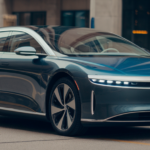Electric vs. gas cars: Which costs less to maintain? We break down oil changes, battery replacements, tire wear, and hidden expenses to reveal the true winner in long-term savings.
The Hidden Costs of Ownership: Electric Vehicles vs. Traditional Cars
The automotive world is at a crossroads, with electric vehicles (EVs) rapidly gaining traction as a cleaner, tech-forward alternative to gas-powered cars. But beyond the buzz of instant torque and zero emissions lies a critical question for buyers: How do maintenance costs really stack up between EVs and traditional vehicles? As an automotive specialist, I’ve dissected repair bills, analyzed long-term ownership data, and even torn down components to uncover the truth. In this article, we’ll break down the real costs of maintaining EVs versus internal combustion engine (ICE) cars, revealing where you’ll save—and where you might get surprised.
Why Maintenance Costs Matter
Maintenance is the silent budget-killer of car ownership. While EVs eliminate many mechanical complexities inherent in ICE vehicles, they introduce new technologies with unique upkeep demands. Understanding these differences is key to calculating your total cost of ownership (TCO)—a metric that can make or break your decision to go electric.
Electric Vehicles: The Low-Maintenance Myth (and Reality)
EVs are often marketed as “virtually maintenance-free,” but let’s dig deeper. Here’s where they shine—and where they don’t:
1. Fewer Moving Parts = Fewer Repairs
- No Oil Changes: EVs skip the engine oil, filters, and timing belts, saving 100–200 annually.
- Regenerative Braking: Reduces wear on brake pads. Some EV drivers go 100,000+ miles without replacement.
- Simpler Drivetrain: No transmission fluid, exhaust systems, or spark plugs to replace.
Savings: Studies show EV maintenance costs are 40% lower than ICE vehicles over the first 100,000 miles (U.S. Department of Energy).
2. The Battery Elephant in the Room
EVs aren’t immune to big-ticket expenses:
- Battery Degradation: Most EV batteries retain 80–90% capacity after 100,000 miles, but replacement costs 5,000–20,000 if out of warranty.
- Coolant Systems: EV batteries require specialized coolant flushes every 50,000–100,000 miles (150–400).
- Software Updates: While often free, some manufacturers charge for advanced diagnostics or feature unlocks.
Pro Tip: Always check the battery warranty (typically 8–10 years) before buying a used EV.
Traditional Cars: The Devil’s in the Details
ICE vehicles have a century of engineering behind them—and a century’s worth of maintenance rituals:
1. Routine Costs Add Up Fast
- Oil Changes: Every 5,000–10,000 miles (50–100 per visit).
- Transmission Fluid: Flushes every 30,000–60,000 miles (150–300).
- Exhaust Systems: Catalytic converters and mufflers can fail, costing 1,000–2,500 to replace.
2. High-Mileage Pitfalls
- Timing Belt Replacement: Critical at 60,000–100,000 miles (500–1,000).
- Engine Repairs: From gasket leaks to turbocharger failures, ICE engines are prone to $2,000+ repair bills as they age.
The Data: AAA estimates annual maintenance costs for ICE vehicles average 1,200+∗∗,comparedto∗∗900 for EVs.
The Hidden Costs Nobody Talks About
1. EV Tire Wear
EVs are heavier (thanks to batteries) and torque-rich, causing tires to wear 20% faster than ICE vehicles. Premium EV-specific tires cost 150–300 each.
2. ICE Fluids and Filters
Beyond oil, ICE cars require frequent coolant, brake fluid, and air filter replacements—costing 200–500 yearly.
3. Depreciation Differences
- EVs: Early models (e.g., Nissan Leaf) depreciated quickly, but newer EVs like Teslas hold value better.
- ICE Vehicles: Luxury sedans and non-hybrids face steep depreciation, impacting TCO.
The Verdict: Which Saves More Long-Term?
- Short-Term (0–5 years): EVs win, with 1,500–3,000 in maintenance savings.
- Long-Term (10+ years): Battery replacement risks tilt the scale. However, federal tax credits and state incentives can offset these costs.
Example: A Tesla Model 3 owner might save $6,000+ over 10 years compared to a Toyota Camry driver (Consumer Reports).
Final Mile: Crunching the Numbers for Your Wallet
While EVs slash routine maintenance, they’re not entirely cost-proof. Your savings depend on:
- Driving Habits: Frequent fast-charging accelerates battery degradation.
- Climate: Extreme heat/cold strains both EV batteries and ICE engines.
- Brand Reliability: Hyundai/Kia’s 10-year battery warranty vs. Tesla’s over-the-air updates.
For urban drivers and tech enthusiasts, EVs are a clear financial win. For rural users or those keeping cars 15+ years, ICE might still edge out—for now.


